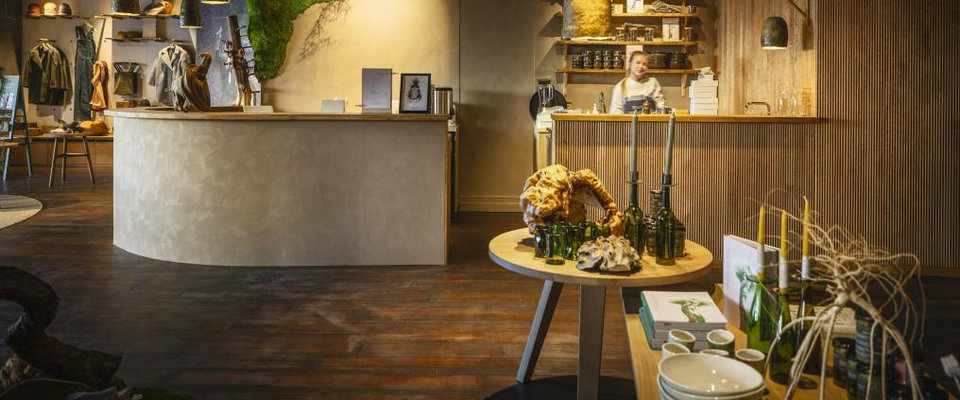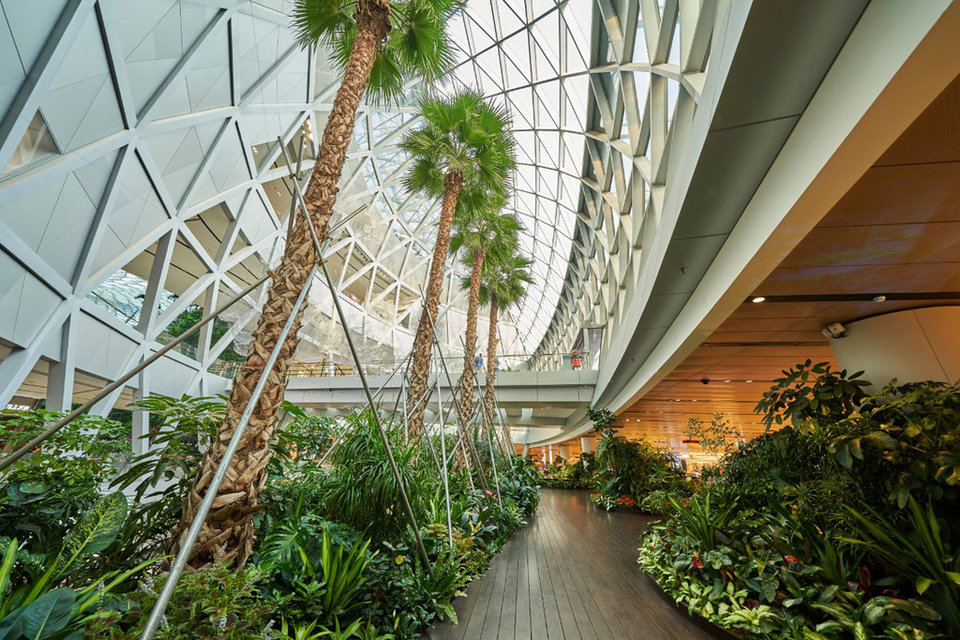Passenger Focus
Walk on the wild side:
how nature is being used to calm air travellers
Natural forests, birdsong and even a glimpse of the aurora borealis are part of a project to soothe passenger nerves at Helsinki Airport. Andrew Tunnicliffe looks at this and other innovative ways airports are trying to relieve stress by bringing the outside in.
Sit back, listen to the birdsong and enjoy the sights and scents of a beautiful Finnish forest. That is exactly what passengers travelling through Helsinki Airport can do, and much more too.
Amidst the hustle and bustle of this international hub, those travelling through it can take time to calm their mind, ease aches and pains and enjoy a cup of Chaga tea along the way. If that doesn’t relieve their stresses, perhaps a stroll through the forest itself – while marvelling at the natural phenomenon that is the aurora borealis – might do the trick.
At Helsinki Airport you can take the opportunity to experience the peace, tranquillity and beauty of the Finnish forest while you wait for your gate to be called. It’s a busy airport too, with 230 routes to 47 countries.
Helsinki Airport vice president of commercial services Nora Immonen. Image: Helsinki Airport

“Finland is well known for its unique clean nature and four seasons,” says Helsinki Airport vice president of commercial services Nora Immonen. The airport has welcomed that nature inside with the introduction of Metsä/Skogen, set to open in May 2020.
Metsä/Skogen stores – one in Helsinki city centre and now one at the airport– focus on nature and sustainability across a range of products aimed at health and wellbeing.
The company says it wants to bring the beauty of Finland’s famous forests into the heart of Finland’s city centres, and now Helsinki’s biggest airport. “Metsä/Skogen is a shop, but more than that it is a place where you calm down and unwind before the flight,” says company CEO Carita Peltonen.

Helsinki Airport is on a quest to reduce travel stress. Image: Finavia Airports
As well as a store, the venues allow visitors to take virtual tours of Finnish forests, enjoy foods with ingredients collected from them, and sample its mushroom bar. The bar showcases the power of mushrooms as an ingredient, along with lichen, forest flowers, berries and wild herbs.
Aside from this experience, visitors can browse a selection of natural cosmetics and food from the forest, as well as small gift items made by Finnish designers.
Image:
The impact nature can have on travellers
The team at Helsinki Airport, which is undergoing significant redevelopment, understands the link between nature and the wellbeing of its passengers. The collaboration with Metsä/Skogen was a concerted effort to improve the experience of travellers passing through.
“I would say, from a traveller’s point of view, there are many benefits,” Immonen says. “First of all, a moment to be still in what often is a hectic airport is a gift in itself. Also, we believe that experiences like this create positive memories and that will have a genuinely positive impact on the traveller’s journey as a whole.”
It is a belief backed by substantial research; numerous studies have concluded spending time in natural surroundings has a benefit on people’s health and wellbeing. “International research shows that walking in nature and observing it helps alleviate stress, counteract depression and lower blood pressure,” says Peltonen, adding the products of the forest work in much the same way.
First of all, a moment to be still in what often is a hectic airport is a gift in itself
What are other airports around the world doing?
Supported by such overwhelming evidence, it is no surprise the project at Helsinki Airport was not the first of its kind. In 2019 Singapore’s Changi Airport underwent a £1bn redevelopment of its own, which resulted in the jungle being brought inside. Spread over five floors, the Jewel boasts 220 different species of plants, 3,000 trees, 10,000 shrubs and the world’s tallest indoor waterfall.

Singapore Changi Jewel Airport. Image: Changi Airport Group
Its structure includes a glass dome, under which sits the jungle, known as Shiseido Forest Valley. The environment is controlled to maintain the best conditions for the plants. The heat stays at 23°C, day and night, and the humidity remains at a tropical 65%. As well as enjoying the tropical greenery, visitors can walk through the birdsong and butterfly gardens, and take one of two nature trails that wind across five storeys spanning the height of the forest.
Opened in 2019, Israel’s Ramon International Airport was designed to make the most of the desert surrounding it. Inside, its courtyards offer weary travellers the opportunity to experience the desert, awash with native plants but shielded from the sunlight. Finishing off the scene, a backdrop of the desert mountains in the distance can be seen, even while inside.
In late 2019, a new terminal was opened at Louis Armstrong International Airport. The increasingly popular destination’s airport had been in need of a facelift for some time – it was 2011 when then New Orleans Mayor Mitchell J. Landrieu first raised the prospect – but the work undertaken as part of the project provided a little more than just a lick of paint.

The Jazz Garden at Louis Armstrong International Airport in New Orleans, US. Image: The New MSY www.thenewmsy.com
Taking its inspiration from the Mississippi river, the exterior design uses curves to represent the river’s path around the city. Inside, natural light is harnessed and enhanced by the calming effect of foliage. The two are complemented by subtle woods.
In 2011, Chicago O’Hare Airport’s Rotunda Building opened an aeroponic garden, the first of its kind to be commissioned for an airport. The garden comprises more than 1,000 plants housed in 26 towers. Some of its produce is served at the sites food outlets too.
Israel’s Ramon International Airport was designed to make the most of the desert surrounding it
Landscaping the future of airport design
A decade or so ago, airports made an effort to introduce natural elements to their interior design concepts as they recognised the stresses felt by some travellers and how they can negatively impact a journey. Although at the time their ambitions were not on the scale of Helsinki or Singapore, their efforts undoubtedly influence the design and customer experience ambitions of airport operators today.

The arrival garden at Singapore Changi’s Terminal 1. Image: Changi Airport Group
However, not all airports are getting it right. In August 2019, designers for the expansion of Marseille Provence Airport were ordered to rethink their proposals by the French Environment Agency. It said the design may not comply with France’s stated aim of becoming a carbon-neutral state by the middle of the century. The airport was also looking at how to incorporate nature into its new design, although the criticisms weren’t directed at those specifically. The concern was that some elements of the design might actually lead to greater daily operational emissions being produced.
For Helsinki Airport, getting the right balance that enables passengers to find peace and respect the natural world around them is vital. As a plethora of studies has shown, nature can benefit even the most stressed of us. Added to that, the magic of Finland’s geography will surely prove popular.
“There is a mythological history in Finland, where nature and the animals are playing a vital part [in] the stories… The traveller can have a glimpse of the beauty and healing power of the Finnish forest, while they’re at the airport,” says Immonen.
“People are often quite stressed in airports - this is a place where you can connect to [the] forest and nature and calm down,” adds Peltonen.
It seems the days of arriving at an airport for a flight and not seeing a tree or plant, bird or butterfly – at least for the duration of your journey – may be numbered.
People are often quite stressed in airports, this is a place where you can connect to forest and nature and calm down